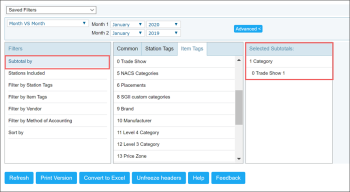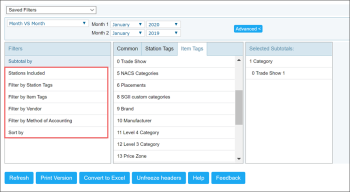This section describes the specifics of accessing and interpreting the Item Sales Comparison report.
Opening Report
You can find the report at Reports > Store > Sales > Item Sales Comparison. For more information, see Viewing Reports.
Viewing Report
The Item Sales Comparison report provides advanced information on the items sold during the specified period or on the specified station in comparison with other period or other station.
To view this report, filter by Item Tags or use subtotals.
The report offers the advanced filter that will help you get the comparison data you need. You can create a comparison view by the following criteria:
- Period-over-period: You can select against which period you want to compare sales for a specific location, for example, year-over-year, quarter-over-quarter or month-over-month.
- Versus other stations: You can compare sales information for a specific location against another location.
- All stations average: You can view the sales average for all locations for a specific period of time.
To view this report:
- Select by which criteria you want to create the comparison view.
- Set the Subtotal by filter. You can filter the report data by common criteria, such as department, price group, promo group and so on..
- (Optional) Refine your report further by using other filtering options. For details, see Filtering and Sorting Report Data.
- Click Refresh to get the report data according to the configured filter.
The report contains the following information:
- UPC: The UPC of the sold item. Click the item UPC to see the item movement details.
- Item name: The name of the sold item.
- For each comparison period, the report contains the following data
- QTY: The item quantity sold within the period.
- Cost: The item cost.
- Buydown by Purch: The reimbursement amount based on the purchased item quantity.
- Retail: The item retail price.
- Unit Cost: The item purchase value.
- Unit Retail: The item retail price.
- Profit: Profit for the item calculated by the following formula: Profit = Retail + Buydown by Sales + Buydown by Purch - Cost.
- GPM %: Gross Profit Margin calculated by the following formula: GPM = (Retail + Buydown by Sales + Buydown by Purch - Cost) / Retail.
- Non Itemized Sales: The amount of direct sales by department.
- Total: Total amount calculated by the following formula: Total = Non Itemized Sales + Retail.
- Total = Non Itemized Sales + RetailDiff Quantity:
- Diff Cost: The difference between the item cost values in compared periods. The Difference Cost value shows the cost value difference taking into the account buydowns by purchases.
- Diff Retail: The difference between the item retail values in compared periods.
- Diff GPM %: The difference between the item GPM values in compared periods.
For more information on additional report features, see Reports.
Filtering and Sorting Report Data
To get the exact information you need, you can apply filters to the report. To set up a filter, select one or more filtering options. Once the filter is set up, at the bottom of the filter section, click the Refresh button to display the report data by the filter criteria.
The report provides the following filtering and sorting options:
- Way of comparison: Select one of the following ways of comparison:
- Last 12 Month VS Prev 12 Month
- Last 3 Month VS Prev 3 Month
- Period VS Period
- Month VS Month
- Vs Other Stations
- All Stations Average
- In the From: and To: fields, specify the starting and ending dates of the comparison period or periods.
- advanced: Click the advanced button, select one several filtering options you want, and then click[ Refresh. There are the following advanced filtering options available:
- Subtotal By: Select one or several filtering options - by Common, Station tags, Item tags - for the further breakdown of the results.
- Station Included: Select the stations you want to view the report for.
- Filter by Station Tags: Use this option to filter the report data by tags assigned to stations. The generated report will contain data only for those stations to which the selected tags are assigned.
To select tags by which the report data must be filtered, expand the tags tree and select the check boxes next to the necessary tags. You can filter the report data by root tags and tags of the lower level in the tags hierarchy. You can also create a combined filter by selecting different root and child tags. - Filter by Item Tags: Use this option to filter the report data by tags assigned to items. The generated report will contain data only for those items to which the selected tags are assigned.
To select tags by which the report data must be filtered, expand the tags tree and select the check boxes next to the necessary tags. You can filter the report data by root tags and tags of the lower level in the tags hierarchy. You can also create a combined filter by selecting different root and child tags. - Filter by Vendor/Manufacturer: Select this option to filter the report results by specific vendor or manufacturer.
- Filter by Method of Accounting: In the Method of Accounting list, select one of the following options:
- Do not Filter
- Retail Method of Accounting
- Cost Method of Accounting
- Sort by. Select the order of the report columns you want. Select the Ascending or Descending option for the corresponding type of filtering.
Press CTRL to select several items at a time.
Select the Show Only option to view only the information for the selected items, and Show All Except to view the information for all the items except the selected ones.
Additional Actions
To view the large report, select the Freeze headers option to make the column headers move with the data during the scrolling.
To turn this option off, click Unfreeze headers.






